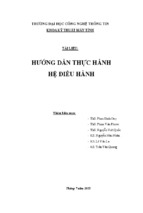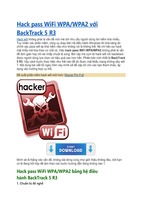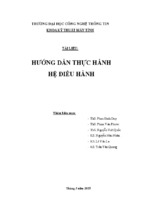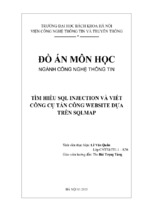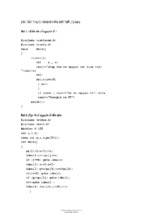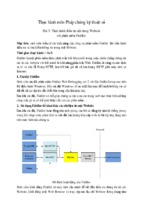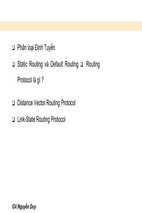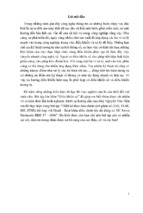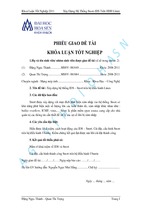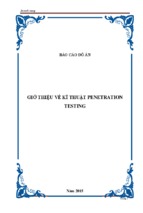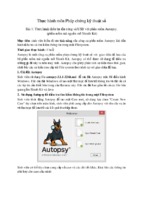Modification
The primary impact of this class of threats is on the integrity requirement. Recall that
integrity, as defined in the GSP, includes both accuracy and completeness of the
information. A hacker attempt would fall into this class of threat if changes were made.
Destruction
A threat, which destroys the asset, falls into the destruction class. Assets that have a
high availability requirement are particularly sensitive to destruction. Threats such as
earthquake, flood, fire and vandalism are within the destruction class.
Removal or Loss
When an asset is subject to theft or has been misplaced or lost, the impact is primarily
on the confidentiality and availability of the asset. Portable computers or laptops are
particularly vulnerable to the threat of removal or loss.
Threat Likelihood
The practitioner must consider, on a per-asset basis, both the type of threat that the
asset may be subjected to and the likelihood of the threat. The likelihood of threat can
be estimated from past experience, from threat information provided by lead agencies
and from sources such as other organizations or services.
Likelihood levels of low, medium and high are used according to the following
definitions (Source: Government of Canada Security Policy):
•
•
•
•
Not Applicable may be used to indicate that a threat is considered not to be
relevant to the situation under review.
Low means there is no history and the threat is considered unlikely to occur.
Medium means there is some history and an assessment that the threat may
occur.
High means there is a significant history and an assessment that the threat is quite
likely to occur.
Consequences, Impact and Exposure
Once the assets are listed and the threats are categorized according to the five major
classes, the practitioner must assess the impact of a threat occurring in the absence of
any safeguards. In order to assess the impact, the practitioner must be able to
understand and describe the business of the organization. The practitioner must
consider what the effect would be on the work being done, on the organization itself,
and on those elements of the business that rely on the information or service provided
by the specific asset under threat.
During this process, the practitioner seeks to answer the question "What is the
consequence of each particular threat?" This consequence is related to the losses or
other consequences (both real and perceived) which could result from a specific threat
being successful.
The Government of Canada Security policy identifies an impact- reporting mechanism
based on an injury assessment. In the case of classified or designated assets or
information, group impact into levels of less serious injury, serious injury and
exceptionally grave injury. Consequences could be expressed in such terms as "loss
of trust", "loss of privacy", "loss of asset" or "loss of service". The practitioner could add
other similarly phrased consequences as needed.
The mapping of the consequence onto one of the three impact ratings (exceptionally
grave, serious, less serious) would vary according to departmental priorities. For
example, in one department a loss of trust might be regarded as serious injury in terms
120
of impact, while in another department, the same loss of trust might be considered to
be exceptionally grave injury. The impact assessment allows the practitioner to
determine the impact to the organization in terms of the real and perceived costs
associated with the loss of confidentiality, integrity, and availability.
The identification of exposure allows the organization to rank the risk scenario
according to the likelihood and impact, and thus assign a priority.
This general exposure rating for data and assets is outlined in Table 4 where impact
takes precedence over likelihood. This table provides a means of prioritizing the impact
through a rating that considers only the likelihood of a particular threat and the associated
impact on the organization should the threat materialize. Table 4 does not consider the
safeguards employed to counterbalance a particular threat.
IMPACT (INJURY)
Exceptionally
Grave
Serious
Less Serious
9
8
5
MEDIUM
7
6
3
LOW
4
2
1
Likelihood
TABLE 4 - Exposure Ratings for Data and Assets
Summarizing Threat Assessment
Threat Assessment as described in this section encompasses:
a) Describing threats in terms of who, how and when.
b) Establishing into which threat class a threat falls.
c) Determining the threat likelihood.
d) Determining the consequences on the business operations should a threat be
successful.
e) Assessing the impact of the consequences as less serious, serious or
exceptionally grave injury.
f) Assigning an exposure rating to each threat, in terms of the relative severity to
the organization.
g) Prioritising the impacts/likelihood pairs, according to the ratings determined in
(f).
Table 5 provides a sample summary sheet on which the threat assessment
information may be entered on a per-asset basis.
121
ASSET
THREAT
AGENT/
EVENT
Describe
the Asset.
Describe
the threat
event.
ASSESSMENT
CLASS OF
THREAT
LIKELIHO
OD OF
OCCURR
ENCE
CONSEQU
ENCE OF
OCCURRE
NCE
IMPACT
(INJURY)
EXPOSURE
RATING
Disclosure
Interruption
Modification
Destruction
Removal
Low
Medium
High
List the
consequenc
es to the
organization
of the threat
occurring.
Exception
ally grave,
serious,
less
serious.
Numerical
Value
1 to 9
TABLE 5 - Generic Threat Assessment
4.2.2.2 RISK ASSESSMENT
Risk assessment is necessary to determine risk assumed by the organization where
existing or proposed safeguards are deemed inadequate to protect the asset
against an identified threat. Where existing safeguards are not adequate, a
vulnerability is noted and analyzed.
Risk assessment is "an evaluation of the chance of vulnerabilities being exploited,
based on the effectiveness of existing or proposed security safeguards".
This definition leads the risk assessment process into an evaluation of the
vulnerabilities and the likelihood that a vulnerability would be exploited by a threat in
the presence of either existing or proposed security measures.
Evaluating Existing Safeguards
Determining what existing safeguards could counter the identified threats is the next
logical step in the process of TRA. Once the existing safeguards are grouped on a
per-threat basis, the practitioner can assess the security posture of the business or
facility relative to each threat, and determine whether any residual vulnerability or
weakness exists.
Vulnerabilities
Attention should be paid to times during which the asset is most vulnerable, for
example, during periods of public access and unrestricted access or while in transit.
In some instances, an asset has an associated time sensitivity. For example, the
information may be sensitive while under review or development (e.g. budget) and
then may lose its sensitivity upon release to the public.
There are three possible security posture scenarios in the threat and safeguards
environment. The first is identified in Figure 2 as an equilibrium state. This state of
equilibrium is the most desirable security posture. In this environment, threats are
122
identified and appropriate safeguards are in place to reduce the associated risks to
a level, which is acceptable to the organization's senior management.
The second security posture, which an organization might experience, is referred to
as a vulnerable state (Figure 3), since the threats outweigh the safeguards. The
insecurity produced can result in a variety of IT - related losses, which compromise
the confidentiality, integrity and availability of the information.
The third security posture is referred to as an excessive
state (Figure 4) since the safeguards employed exceed
the threats. The result is an overspending in the area
of security measures, which is not commensurate with
the threat; and thus is not justifiable.
When it is determined that the security posture
matches Figure 3 - Vulnerable, the practitioner must
consider the possibility that a vulnerability would be
exploited. This depends on a number of factors,
some of which were explored in the Threat
Assessment:
•
•
•
•
likelihood of threat,
possible motive for exploiting the vulnerability,
value of the asset to the organization and to the
threat agent, and
effort required to exploit the vulnerability.
Figure2
Figure3
For example, a vulnerability could exist but, in the
absence of one or more of the above factors, it may
never be exploited.
Figure4
Risk
Risk is defined as, "the chance of vulnerabilities being exploited".
The level of risk existing in the organization can be categorized as:
•
•
•
high: requiring immediate attention and safeguard implementation,
medium: requiring attention and safeguard implementation in the near future, or
low: requiring some attention and consideration for safeguard implementation
as good business practice.
The practitioner will be able to decide the priority for each component of the risk
management program based on items such as the nature of identified threats and
the impact on the organization. Having reviewed the existing safeguards and
vulnerabilities, the practitioner establishes the adequacy of safeguards and
recommends change. For an example of establishing risk for deliberate threat
scenarios, refer to Annex E.
Summarizing Risk Assessment
Risk Assessment as described in this section encompasses:
•
examining existing safeguards,
123
•
•
establishing vulnerabilities, and
determining the level of risk based on a number of factors.
Table 6 provides a sample summary sheet for entering the risk assessment
information on a per-asset basis.
ASSET
THREAT
Risk Assessment
Existing
Safeguards
Describe the
Asset
Describe the
specific threat
against it
Describe existing
safeguards to
protect the asset
against the threat
Vulnerability
Describe any
vulnerabilities that
may be observed
RISK
Establish risk
level
TABLE 6 - Generic Risk Assessment
4.2.2.3 RECOMMENDATIONS
The closing phase of the TRA process includes the proposal of recommendations.
These recommendations are intended to improve the security posture of the
organization through risk reduction, provide considerations for business recovery
activities should a threat cause damage, and identify implementation constraints.
Once safeguards that would augment the existing safeguards and improve the
security profile are proposed, the risk posture can be re-evaluated as low, medium
or high.
Proposed Safeguards
At this point in the process, the practitioner has analyzed the nature of the threats,
the impact of successful threats, and the organization's vulnerability to these threats
and has subsequently judged the risk to be low, medium, or high. Where the
practitioner perceives that the risk can be reduced, appropriate recommendations
are made. The practitioner may recommend a number of scenarios, each with an
associated effect and cost, from which senior management will make an appropriate
selection.
Where the assessment of threats and associated risks leads to specific
recommendations, the practitioner must also consider the feasibility of such
recommendations.
Projected Risk
In some instances, proposed safeguards will reduce or eliminate some, but not all,
risks. For such instances, the resulting projected risk should be documented and
signed off by senior management. For example, the initial risk assessment
indicated a high risk situation, and several safeguards were recommended by the
TRA team. In the presence of these additional safeguards, the risk is re-evaluated
as being moderate to low. Thus the priority level of this scenario is reduced but not
eliminated, and senior management should acknowledge and accept or reject the
124
projected risk levels. Rejecting the risk implies that other safeguards must be
sought to further reduce or eliminate the risk.
Ranking of the implemented safeguards can be accomplished in a number of ways,
for example:
•
•
Refer to the impact-rating column of the threat assessment phase
Compare the change in risk level before a proposed safeguard is implemented,
in the risk assessment phase risk column to after, in the recommendations
phase risk column.
Impact ratings of 9 should be looked at first because they represent events that
have high likelihood and very serious impact. In some instances the change in risk
level from high to low is desirable, in particular where the exposure rating is high.
Overall Assessment of Safeguards
Safeguards and associated risk should be evaluated based on the following
categories:
•
•
•
completely satisfactory;
satisfactory in most aspects;
needs improvement.
The risks of deliberate threats to the organization have been established by way of
the Risk Assessment Grid described in Appendix E. For accidental threats, the risk
will be assessed according to their history within the organization or similar
institutions and the observed effectiveness of associated safeguards in each
comparable environment. The highest priority must be assigned to those threats
posing a high risk to the organization. For each of these threats, the practitioner will
propose safeguards to eliminate the risk or reduce it to a level acceptable to senior
management. The adequacy of each of these proposed safeguards must be
evaluated as completely satisfactory, satisfactory in most aspects, or needs
improvement.
The practitioner establishes the appropriateness and interdependencies of
safeguards, and answers such questions as: Are safeguards in conflict? Does one
safeguard offset the usefulness of another? Does the safeguard overcompensate
the threat? What threats have not been fully compensated for? What is the risk that
vulnerabilities which are not fully compensated for are likely to be exploited and by
whom?
4.2.3 Updates
The TRA is considered to be a vital, living document, which is essential to meeting
the security objectives of the organization. The TRA must be updated at least
annually, or whenever an occurrence reveals a deficiency in the existing
assessment. The TRA should also be updated whenever changes are planned to
the systems or environments in which the IT processing occurs, which could create
new risks or redundant safeguards.
Regular Review
Regular reviews allow the practitioner to revisit the TRA document and assess
whether the IT security requirements within the organization have changed. These
regular reviews are necessary in light of both the dynamics of the technologies in
place to support IT and the dynamics of technologies available to threat agents to
help them attack the IT systems of the organization.
125
Systems Changes
Changes to systems can greatly impact the security profile; therefore, every change
must be assessed. The TRA document provides the practitioner with a baseline
against which the effects of these changes can be measured. Examples of
changes include the move of an organization from stand-alone PCs to a Local Area
Network environment, the introduction of new applications to existing systems, the
introduction of Wide Area Network capability to existing IT environments, a change
in communications links or protocols used to move information between
departmental units, or a change in the level of the most sensitive information on the
system.
Threat Profile Changes
Changes in the threat profile will also have a potential impact on the TRA. For
example, when threat agent motivation diminishes or the effort expended by the
threat agent increases, the threat from that source may be reduced. Since changes
in the threat profile do not always follow a cyclical pattern, the practitioner must stay
in touch with the current threat levels and update the TRA accordingly.
4.2.4 Advice and Guidance
Threats
Sources of historical threat information vary, depending on the type of information
sought. For threat information based on events that have already occurred within
the organization, the practitioner should consult the Departmental Security Officer.
For threat information related to investigations under the Criminal Code of Canada
involving IT assets, the practitioner should consult the OIC, Information Technology
(IT) Security Branch of the RCMP. Where threat information relates to COMSEC,
the practitioner should consult the Communications Security Establishment. The
Canadian Security Intelligence Service (CSIS) provides threat information and
advice on threat assessment when requested.
TRA Process
Advice and guidance on the TRA process as described in this document are
available through the OIC,IT Security Branch of the RCMP.
126
4.2.5 Glossary of Terms
1. Analyse: to study or determine the nature and relationship of the parts.
2. Assess: to evaluate the extent to which certain factors (Threats, Vulnerabilities
and Risks) affect the IT environment.
3. Asset: any item that has value.
4. Availability: the condition of being usable on demand to support business
functions.
5. Compromise: unauthorized disclosure, destruction, removal, modification or
interruption.
6. Confidentiality: the sensitivity of information or assets to unauthorized
disclosure, recorded as classification or designation, each of which implies a
degree of injury should unauthorized disclosure occur.
7. Consequence: outcome, effect.
8. Critical: crucial, decisive.
9. Equilibrium: a state of balance existing between two or more opposing forces.
10. Evaluate: to determine the amount or worth of, or to appraise.
11. Exposure: the state of being vulnerable to criticism or attack.
12. Impact: effect of one thing on another.
13. Information technology: The scientific, technological and engineering
disciplines and the management technologies used in information handling,
communication and processing; the fields of electronic data processing,
telecommunications, networks, and their convergence in systems; applications
and associated software and equipment together with their interaction with
humans and machines.
14. Intangible: incapable of being perceived by touch.
15. Integrity: the accuracy and completeness of information and assets and the
authenticity of transactions.
16. Likelihood: the state or quality of being probable, probability.
17. Practitioner: one who practises within an area of expertise.
18. Process: a series of continuous actions to bring about a result.
19. Qualitative: of or pertaining to quality, describable.
20. Quantitative: of or pertaining to quantity, measurable.
21. Risk assessment: an evaluation of the chance of vulnerabilities being
exploited, based on the effectiveness of existing or proposed safeguards.
22. Safeguards: actions or measures taken to offset a particular security concern or
threat.
23. Security baseline: an established security profile or posture, which has been
determined at an established point in time.
24. Tangible: perceptible by touch.
25. Threat assessment: an evaluation of the nature, likelihood and consequence
of acts or events that could place sensitive information and assets as risk.
26. Threat: any potential event or act that could cause one or more of the following
to occur: unauthorized disclosure, destruction, removal, modification or
interruption of sensitive information, assets or services, or injury to people. A
threat may be deliberate or accidental.
127
Section References
4.1 Guideline for the Analysis Local Area Network Security., Federal
Information Processing Standards Publication 191, November 1994.
Chapter 3.4.
[MART89] Martin, James, and K. K. Chapman, The Arben Group, Inc.; Local
Area Networks, Architectures and Implementations, Prentice Hall,
1989.
[BARK89] Barkley, John F., and K. Olsen; Introduction to Heterogenous
Computing Environments, NIST Special Publication 500-176,
November, 1989.
[NCSC87] A Guide to Understanding Discretionary Access Control in Trusted
Systems, NCSC-TG-003, Version 1, September 30, 1987
[NCSL90] National Computer Systems Laboratory (NCSL) Bulletin, Data
Encryption Standard, June, 1990.
[SMID88] Smid, Miles, E. Barker, D. Balenson, and M. Haykin; Message
Authentication Code (MAC) Validation System: Requirements and
Procedures, NIST Special Publication 500-156, May, 1988.
[OLDE92] Oldehoeft, Arthur E.; Foundations of a Security Policy for Use of
the National Research and Educational Network, NIST Interagency
Report, NISTIR 4734, February 1992.
[COMM91] U.S. Department of Commerce Information Technology
Management Handbook, Attachment 13-D: Malicious Software
Policy and Guidelines, November 8, 1991.
[WACK89] Wack, John P., and L. Carnahan; Computer Viruses and Related
Threats: A Management Guide, NIST Special Publication 500-166,
August 1989.
[X9F292] Information Security Guideline for Financial Institutions, X9/TG-5,
Accredited Committee X9F2, March 1992.
[BJUL93] National Computer Systems Laboratory (NCSL) Bulletin, Connecting to the
Internet: Security Considerations, July 1993.
[BNOV91] National Computer Systems Laboratory (NCSL) Bulletin, Advanced
Authentication Technology, November 1991.
[KLEIN] Daniel V. Klein, "Foiling the Cracker: A Survey of, and Improvements to,
Password Security", Software Engineering Institute. (This work was sponsored in
part by the Department of Defense.)
[GILB89] Gilbert, Irene; Guide for Selecting Automated Risk Analysis Tools,
NIST Special Publication 500-174, October, 1989.
[KATZ92] Katzke, Stuart W. ,Phd., "A Framework for Computer Security Risk
Management", NIST, October, 1992.
[NCSC85] Department of Defense Password Management Guideline, National Computer
Security Center, April, 1985.
[NIST85] Federal Information Processing Standard (FIPS PUB) 112, Password Usage,
May,1985.
[ROBA91] Roback Edward, NIST Coordinator, Glossary of Computer Security
Terminology,NISTIR 4659, September, 1991.
[TODD89] Todd, Mary Anne and Constance Guitian, Computer Security Training
Guidelines,NIST Special Publication 500-172, November, 1989.
[STIE85] Steinauer, Dennis D.; Security of Personal Computer Systems: A
128
Management Guide, NBS Special Publication 500-120, January,
1985.
[WACK91] Wack, John P.; Establishing a Computer Security Incident
Response Capability (CSIRC), NIST Special Publication 800-3,
November, 1991.
[NIST74] Federal Information Processing Standard (FIPS PUB) 31,
Guidelines for Automatic Data Processing Physical Security and
Risk Management, June, 1974.
4.2 Royal Canadian Mounted Police Technical Operations Directorate. Information
Technology Security Branch. Guide to Threat and Risk Assessment. For Information
Technology. Security Information Publications, November 1994.
129
5.0 Firewalls
5.1 Introduction
Perhaps it is best to describe first what a firewall is not: A firewall is not simply a router,
host system, or collection of systems that provides security to a network. Rather, a
firewall is an approach to security; it helps implement a larger security policy that defines
the services and access to be permitted, and it is an implementation of that policy in
terms of a network configuration, one or more host systems and routers, and other
security measures such as advanced authentication in place of static passwords. The
main purpose of a firewall system is to control access to or from a protected network (i.e.,
a site). It implements a network access policy by forcing connections to pass through the
firewall, where they can be examined and evaluated. A firewall system can be a router, a
personal computer, a host, or a collection of hosts, set up specifically to shield a site or
subnet from protocols and services that can be abused from hosts outside the subnet. A
firewall system is usually located at a higher level gateway, such as a site's connection to
the Internet, however firewall systems can be located at lower-level gateways to provide
protection for some smaller collection of hosts or subnets.
The main function of a firewall is to centralize access control. A firewall serves as the
gatekeeper between the untrusted Internet and the more trusted internal networks. If
outsiders or remote users can access the internal networks without going through the
firewall, its effectiveness is diluted. For example, if a traveling manager has a modem
connected to his office PC that he or she can dial into while traveling, and that PC is also
on the protected internal network, an attacker who can dial into that PC has circumvented
the firewall. Similarly, if a user has a dial-up Internet account with a commercial ISP, and
sometimes connects to the Internet from their office PC via modem, he or she is opening
an unsecured connection to the Internet that circumvents the firewall.
What is being protected by firewalls?
•
•
•
Your data
Secrecy - what others should not know
Integrity - what others should not change
Availability - your ability to use your own systems
Your resources
Your systems and their computational capabilities
Your reputation
Confidence is shaken in your organization
Your site can be used as a launching point for crime
You may be used as a distribution site for unwanted data
You may be used by impostors to cause serious problems
You may be viewed as “untrusted” by customers and peers
Firewalls provide several types of protection:
•
•
•
•
•
•
They can block unwanted traffic.
They can direct incoming traffic to more trustworthy internal systems.
They hide vulnerable systems, which can’t easily be secured from the Internet.
They can log traffic to and from the private network.
They can hide information like system names, network topology, network device
types, and internal user ID’s from the Internet.
They can provide more robust authentication than standard applications might be
able to do.
130
As with any safeguard, there are trade-offs between convenience and security.
Transparency is the visibility of the firewall to both inside users and outsiders going
through a firewall. A firewall is transparent to users if they do not notice or stop at the
firewall in order to access a network. Firewalls are typically configured to be transparent
to internal network users (while going outside the firewall); on the other hand, firewalls are
configured to be non-transparent for outside network coming through the firewall. This
generally provides the highest level of security without placing an undue burden on
internal users.
5.2 Firewall Security and Concepts
• The amount of security required for an entity is based on the security threat
• If you do not know what your threat is to the Intranet systems, it is extremely
difficult to properly secure the environment and all systems interconnected
• Network compartmentalization is the buzzword for this type of effort
• Switching technology is a big help, but it does not tell you who is going where
and why - that’s what analysis is all about
• Not knowing the threat causes false security to be deployed and money spent in the
wrong places
The main reasons for systems and computers not being secure are
• Lack of password encryption
• Lack of personnel with experience
• Lack of management backing
• Authority
• Responsibility
• Legal and political issues
• Lack of recurring effort
• Budget
5.2.0 Firewall Components
The primary components (or aspects) of a firewall are:
•
•
•
Network policy,
Advanced authentication mechanisms,
Packet filtering, and Application gateways.
The following sections describe each of these components more fully.
5.2.0.0 NETWORK POLICY
There are two levels of network policy that directly influence the design, installation and
use of a firewall system. The higher-level policy is an issue-specific, network access
policy that defines those services that will be allowed or explicitly denied from the
restricted network, how these services will be used, and the conditions for exceptions to
this policy. The lower-level policy describes how the firewall will actually go about
restricting the access and filtering the services that were defined in the higher level policy.
The following sections describe these policies in brief.
5.2.0.1 SERVICE ACCESS POLICY
The service access policy should focus on Internet-specific use issues as defined above,
and perhaps all outside network access (i.e., dial-in policy, and SLIP and PPP
connections) as well. This policy should be an extension of an overall organizational
policy regarding the protection of information resources in the organization. For a firewall
to be successful, the service access policy must be realistic and sound and should be
131
drafted before implementing a firewall. A realistic policy is one that provides a balance
between protecting the network from known risks, while still providing users access to
network resources. If a firewall system denies or restricts services, it usually requires the
strength of the service access policy to prevent the firewall's access controls from being
modified on an ad hoc basis. Only a management-backed, sound policy can provide this.
A firewall can implement a number of service access policies, however a typical policy
may be to allow no access to a site from the Internet, but allow access from the site to the
Internet. Another typical policy would be to allow some access from the Internet, but
perhaps only to selected systems such as information servers and e-mail servers.
Firewalls often implement service access policies that allow some user access from the
Internet to selected internal hosts, but this access would be granted only if necessary and
only if it could be combined with advanced authentication.
5.2.0.2 FIREWALL DESIGN POLICY
The firewall design policy is specific to the firewall. It defines the rules used to implement
the service access policy. One cannot design this policy in a vacuum isolated from
understanding issues such as firewall capabilities and limitations, and threats and
vulnerabilities associated with TCP/IP. Firewalls generally implement one of two basic
design policies:
•
permit any service unless it is expressly denied, and
•
deny any service unless it is expressly permitted.
A firewall that implements the first policy allows all services to pass into the site by
default, with the exception of those services that the service access policy has identified
as disallowed. A firewall that implements the second policy denies all services by default,
but then passes those services that have been identified as allowed. This second policy
follows the classic access model used in all areas of information security.
The first policy is less desirable, since it offers more avenues for getting around the
firewall, e.g., users could access new services currently not denied by the policy (or even
addressed by the policy) or run denied services at non-standard TCP/UDP ports that
aren't denied by the policy. Certain services such as X Windows, FTP, Archie, and RPC
cannot be filtered easily [Chap92], [Ches94], and are better accommodated by a firewall
that implements the first policy. The second policy is stronger and safer, but it is more
difficult to implement and may impact users more in that certain services such as those
just mentioned may have to be blocked or restricted more heavily.
The relationship between the high level service access policy and its lower level
counterpart is reflected in the discussion above. This relationship exists because the
implementation of the service access policy is so heavily dependent upon the capabilities
and limitations of the firewall system, as well as the inherent security problems
associated with the wanted Internet services. For example, wanted services defined in
the service access policy may have to be denied if the inherent security problems in
these services cannot be effectively controlled by the lower level policy and if the security
of the network takes precedence over other factors. On the other hand, an organization
that is heavily dependent on these services to meet its mission may have to accept
higher risk and allow access to these services. This relationship between the service
access policy and its lower level counterpart allows for an iterative process in defining
both, thus producing the realistic and sound policy initially described.
The service access policy is the most significant component of the four described here.
The other three components are used to implement and enforce the policy. (And as
132
noted above, the service access policy should be a reflection of a strong overall
organization security policy.) The effectiveness of the firewall system in protecting the
network depends on the type of firewall implementation used, the use of proper firewall
procedures, and the service access policy.
5.2.1 Advanced Authentication
Sections 1.3,1.3.1, and 1.3.2 describe incidents on the Internet that have occurred in part
due to the weaknesses associated with traditional passwords. For years, users have
been advised to choose passwords that would be difficult to guess and to not reveal their
passwords. However, even if users follow this advice (and many do not), the fact that
intruders can and do monitor the Internet for passwords that are transmitted in the clear
has rendered traditional passwords obsolete.
Advanced authentication measures such as smartcards, authentication tokens,
biometrics, and software-based mechanisms are designed to counter the weaknesses of
traditional passwords. While the authentication techniques vary, they are similar in that
the passwords generated by advanced authentication devices cannot be reused by an
attacker who has monitored a connection. Given the inherent problems with passwords
on the Internet, an Internet-accessible firewall that does not use or does not contain the
hooks to use advanced authentication makes little sense.
Some of the more popular advanced authentication devices in use today are called onetime password systems. A smartcard or authentication token, for example, generates a
response that the host system can use in place of a traditional password. Because the
token or card works in conjunction with software or hardware on the host, the generated
response is unique for every login. The result is a one-time password that, if monitored,
cannot be reused by an intruder to gain access to an account. [NIST94a] and [NIST91a]
contain more detail on advanced authentication devices and measures.
Since firewalls can centralize and control site access, the firewall is the logical place for
the advanced authentication software or hardware to be located. Although advanced
authentication measures could be used at each host, it is more practical and manageable
to centralize the measures at the firewall. Figure above illustrates that a site without a
firewall using advanced authentication permits unauthenticated application traffic such as
TELNET or FTP directly to site systems. If the hosts do not use advanced authentication,
then intruders could attempt to crack passwords or could monitor the network for login
sessions that would include the passwords. Figure above also shows a site with a firewall
using advanced authentication, such that TELNET or FTP sessions originating from the
Internet to site systems must pass the advanced authentication before being permitted to
the site systems. The site systems may still require static passwords before permitting
access, however these passwords would be immune from exploitation, even if the
passwords are monitored, as long as the advanced authentication measures and other
firewall components prevent intruders from penetrating or bypassing the firewall.
5.3 Packet Filtering
IP packet filtering is done usually using a packet filtering router designed for filtering
packets as they pass between the router's interfaces. A packet filtering router usually can
filter IP packets based on some or all of the following fields:
•
•
•
•
source IP address,
destination IP address,
TCP/UDP source port, and
TCP/UDP destination port.
133
Not all packet filtering routers currently filter the source TCP/UDP port, however more
vendors are starting to incorporate this capability. Some routers examine which of the
router's network interfaces a packet arrived at, and then use this as an additional filtering
criterion. Some UNIX hosts provide packet filtering capability, although most do not.
Filtering can be used in a variety of ways to block connections from or to specific hosts or
networks, and to block connections to specific ports. A site might wish to block
connections from certain addresses, such as from hosts or sites that it considers to be
hostile or untrustworthy. Alternatively, a site may wish to block connections from all
addresses external to the site (with certain exceptions, such as with SMTP for receiving
e-mail).
Adding TCP or UDP port filtering to IP address filtering results in a great deal of flexibility.
Recall from Chapter 1 that servers such as the TELNET daemon reside usually at
specific ports, such as port 23 for TELNET. If a firewall can block TCP or UDP
connections to or from specific ports, then one can implement policies that call for certain
types of connections to be made to specific hosts, but not other hosts. For example, a
site may wish to block all incoming connections to all hosts except for several firewallsrelated systems. At those systems, the site may wish to allow only specific services, such
as SMTP for one system and TELNET or FTP connections to another system. With
filtering on TCP or UDP ports, this policy can be implemented in a straightforward fashion
by a packet filtering router or by a host with packet filtering capability.
As an example of packet filtering, consider a policy to allow only certain connections to a
network of address 123.4.*.*. TELNET connections will be allowed to only one host,
123.4.5.6, which may be the site's TELNET application gateway, and SMTP connections
will be allowed to two hosts, 123.4.5.7 and 123.4.5.8, which may be the site's two
electronic mail gateways. NNTP (Network News Transfer Protocol) is allowed only from
the site's NNTP feed system, 129.6.48.254, and only to the site's NNTP server,
123.4.5.9, and NTP (Network Time Protocol) is allowed to all hosts. All other services and
packets are to be blocked. An example of the rule set would be as follows:
he first rule allows TCP packets from any source address and port greater than 1023 on
the Internet to the destination address of 123.4.5.6 and port of 23 at the site. Port 23 is
the port associated with the TELNET server, and all TELNET clients should have
unprivileged source ports of 1024 or higher. The second and third rules work in a similar
fashion, except packets to destination addresses 123.4.5.7 and 123.4.5.8, and port 25 for
SMTP, are permitted. The fourth rule permits packets to the site's NNTP server, but only
from source address 129.6.48.254 to destination address 123.4.5.9 and port 119
(129.6.48.254 is the only NNTP server that the site should receive news from, thus
access to the site for NNTP is restricted to only that system). The fifth rule permits NTP
traffic, which uses UDP as opposed to TCP, from any source to any destination address
at the site. Finally, the sixth rule denies all other packets - if this rule weren't present, the
router may or may not deny all subsequent packets. This is a very basic example of
packet filtering. Actual rules permit more complex filtering and greater flexibility.
5.3.0 Which Protocols to Filter
The decision to filter certain protocols and fields depends on the network access policy,
i.e., which systems should have Internet access and the type of access to permit. The
following services are inherently vulnerable to abuse and are usually blocked at a firewall
from entering or leaving the site [Chap92], [Garf92]:
•
tftp, port 69, trivial FTP, used for booting diskless workstations, terminal servers and
routers, can also be used to read any file on the system if set up incorrectly,
134
•
•
•
X Windows, OpenWindows, ports 6000+, port 2000, can leak information from X
window displays including all keystrokes,
RPC, port 111, Remote Procedure Call services including NIS and NFS, which can
be used to steal system information such as passwords and read and write to files,
and
rlogin, rsh, and rexec, ports 513, 514, and 512, services that if improperly configured
can permit unauthorized access to accounts and commands.
Other services, whether inherently dangerous or not, are usually filtered and possibly
restricted to only those systems that need them. These would include:
•
•
•
•
•
•
•
TELNET, port 23, often restricted to only certain systems,
FTP, ports 20 and 21, like TELNET, often restricted to only certain systems,
SMTP, port 25, often restricted to a central e-mail server,
RIP, port 520, routing information protocol, can be spoofed to redirect packet routing,
DNS, port 53, domain names service zone transfers, contains names of hosts and
information about hosts that could be helpful to attackers, could be spoofed,
UUCP, port 540, UNIX-to-UNIX CoPy, if improperly configured can be used for
unauthorized access,
NNTP, port 119, Network News Transfer Protocol, for accessing and reading
network news, and gopher, http (for Mosaic), ports 70 and 80, information servers
and client programs for gopher and WWW clients, should be restricted to an
application gateway that contains proxy services.
While some of these services such as TELNET or FTP are inherently risky, blocking
access to these services completely may be too drastic a policy for many sites. Not all
systems, though, generally require access to all services. For example, restricting
TELNET or FTP access from the Internet to only those systems that require the access
can improve security at no cost to user convenience. Services such as NNTP may seem
to pose little threat, but restricting these services to only those systems that need them
helps to create a cleaner network environment and reduces the likelihood of exploitation
from yet-to-be-discovered vulnerabilities and threats.
5.3.1 Problems with Packet Filtering Routers
Packet filtering routers suffer from a number of weaknesses, as described in [Chap92].
Packet filtering rules are complex to specify and usually no testing facility exists for
verifying the correctness of the rules (other than by exhaustive testing by hand). Some
routers do not provide any logging capability, so that if a router's rules still let dangerous
packets through, the packets may not be detected until a break-in has occurred.
Often times, exceptions to rules need to be made to allow certain types of access that
normally would be blocked. But, exceptions to packet filtering rules sometimes can make
the filtering rules so complex as to be unmanageable. For example, it is relatively
straightforward to specify a rule to block all inbound connections to port 23 (the TELNET
server). If exceptions are made, i.e., if certain site systems need to accept TELNET
connections directly, then a rule for each system must be added. Sometimes the addition
of certain rules may complicate the entire filtering scheme. As noted previously, testing a
complex set of rules for correctness may be so difficult as to be impractical.
Some packet filtering routers do not filter on the TCP/UDP source port, which can make
the filtering rule set more complex and can open up ``holes'' in the filtering scheme.
[Chap92] describes such a problem with sites that wish to allow inbound and outbound
SMTP connections. As described in section , TCP connections include a source and
destination port. In the case of a system initiating an SMTP connection to a server, the
source port would be a randomly chosen port at or above 1024 and the destination port
135
would be 25, the port that the SMTP server “listens” at. The server would return packets
with source port of 25 and destination port equal to the randomly-chosen port at the
client. If a site permits both inbound and outbound SMTP connections, the router must
allow destination ports and source ports > 1023 in both directions. If the router can filter
on source port, it can block all packets coming into the site that have a destination port >
1023 and a source port other than 25. Without the ability to filter on source port, the router
must permit connections that use source and destination ports > 1024.
Users could conceivably run servers at ports > 1023 and thus get “around” the filtering
policy (i.e., a site system's telnet server that normally listens at port 23 could be told to
listen at port 9876 instead; users on the Internet could then telnet to this server even if the
router blocks destination port 23).
Another problem is that a number of RPC (Remote Procedure Call) services are very
difficult to filter effectively because the associated servers listen at ports that are assigned
randomly at system startup. A service known as portmapper maps initial calls to RPC
services to the assigned service numbers, but there is no such equivalent for a packet
filtering router. Since the router cannot be told which ports the services reside at, it isn't
possible to block completely these services unless one blocks all UDP packets (RPC
services mostly use UDP). Blocking all UDP would block potentially necessary services
such as DNS. Thus, blocking RPC results in a dilemma.
Packet filtering routers with more than two interfaces sometimes do not have the
capability to filter packets according to which interface the packets arrived at and which
interface the packet is bound for. Filtering inbound and outbound packets simplifies the
packet filtering rules and permits the router to more easily determine whether an IP
address is valid or being spoofed. Routers without this capability offer more impediments
to implementing filtering strategies.
Related to this, packet filtering routers can implement both of the design policies
discussed in section 2.4.1. A rule set that is less flexible, i.e., that does not filter on source
port or on inbound and outbound interfaces, reduces the ability of the router to implement
the second and more stringent policy, deny all services except those expressly permitted,
without having to curtail the
types of services permitted through the router. For example, problematic services such
as those that are RPC-based become even more difficult to filter with a less-flexible rule
set; no filtering on source port forces one to permit connections between ports > 1023.
With a less-flexible rule set, the router is less able to express a stringent policy, and the
first policy, permit all services except those expressly permitted, is usually followed.
Readers are advised to consult [Chap92], which provides a concise overview of packet
filtering and associated problems. While packet filtering is a vital and important tool, it is
very important to understand the problems and how they can be addressed.
5.3.1.0 APPLICATION GATEWAYS
To counter some of the weaknesses associated with packet filtering routers, firewalls
need to use software applications to forward and filter connections for services such as
TELNET and FTP. Such an application is referred to as a proxy service, while the host
running the proxy service is referred to as an application gateway. Application gateways
and packet filtering routers can be combined to provide higher levels of security and
flexibility than if either were used alone.
As an example, consider a site that blocks all incoming TELNET and FTP connections
using a packet filtering router. The router allows TELNET and FTP packets to go to one
136
host only, the TELNET/FTP application gateway. A user who wishes to connect inbound
to a site system would have to connect first to the application gateway, and then to the
destination host, as follows:
•
•
•
•
•
•
a user first telnets to the application gateway and enters the name of an internal host,
the gateway checks the user's source IP address and accepts or rejects it according
to any access criteria in place,
the user may need to authenticate herself (possibly using a one-time password
device),
the proxy service creates a TELNET connection between the gateway and the
internal host,
the proxy service then passes bytes between the two connections, and
the application gateway logs the connection.
This example points out several benefits to using proxy services. First, proxy services
allow only those services through for which there is a proxy. In other words, if an
application gateway contains proxies for FTP and TELNET, then only FTP and TELNET
may be allowed into the protected subnet, and all other services are completely blocked.
For some sites, this degree
of security is important, as it guarantees that only those services that are deemed
``trustworthy'' are allowed through the firewall. It also prevents other untrusted services
from being implemented behind the backs of the firewall administrators.
Another benefit to using proxy services is that the protocol can be filtered. Some firewalls,
for example, can filter FTP connections and deny use of the FTP put command, which is
useful if one wants to guarantee that users cannot write to, say, an anonymous FTP
server.
Application gateways have a number of general advantages over the default mode of
permitting application traffic directly to internal hosts. These include:
•
•
•
•
information hiding, in which the names of internal systems need not necessarily be
made known via DNS to outside systems, since the application gateway may be the
only host whose name must be made known to outside systems,
robust authentication and logging, in which the application traffic can be preauthenticated before it reaches internal hosts and can be logged more effectively
than if logged with standard host logging,
cost-effectiveness, because third-party software or hardware for authentication or
logging need be located only at the application gateway, and
less-complex filtering rules, in which the rules at the packet filtering router will be less
complex than they would if the router needed to filter application traffic and direct it to
a number of specific systems. The router need only allow application traffic destined
for the application gateway and reject the rest.
A disadvantage of application gateways is that, in the case of client-server protocols such
as TELNET, two steps are required to connect inbound or outbound. Some application
gateways require modified clients, which can be viewed as a disadvantage or an
advantage, depending on whether the modified clients make it easier to use the firewall.
A TELNET application gateway would not necessarily require a modified TELNET client,
however it would require a modification in user behavior: the user has to connect (but not
login) to the firewall as opposed to connecting directly to the host. But a modified
TELNET client could make the firewall transparent by permitting a user to specify the
destination system (as opposed to the firewall) in the TELNET command. The firewall
137
would serve as the route to the destination system and thereby intercept the connection,
and then perform additional steps as necessary such as querying for a one-time
password. User behavior stays the same, however at the price of requiring a modified
client on each system.
In addition to TELNET, application gateways are used generally for FTP and e-mail, as
well as for X Windows and some other services. Some FTP application gateways include
the capability to deny put and get command to specific hosts. For example, an outside
user who has established an FTP session (via the FTP application gateway) to an
internal system such as an anonymous FTP server might try to upload files to the server.
The application gateway can filter the FTP protocol and deny all puts to the anonymous
FTP server; this would ensure that nothing can be uploaded to the server and would
provide a higher degree of assurance than relying only on file permissions at the
anonymous FTP server to be set correctly.
An e-mail application gateway serves to centralize e-mail collection and distribution to
internal hosts and users. To outside users, all internal users would have e-mail
addresses of the form:
user@emailhost
where emailhost is the name of the e-mail gateway. The gateway would accept mail from
outside users and then forward mail along to other internal systems as necessary. Users
sending e-mail from internal systems could send it directly from their hosts, or in the case
where internal system names are not known outside the protected subnet, the mail would
be sent to the application gateway, which could then forward the mail to the destination
host. Some e-mail gateways use a more secure version of the sendmail program to
accept e-mail.
5.3.1.1 CIRCUIT-LEVEL GATEWAYS
[Ches94] defines another firewall component that other authors sometimes include under
the category of application gateway. A circuit-level gateway relays TCP connections but
does no extra processing or filtering of the protocol. For example, the TELNET
application gateway example provided here would be an example of a circuit-level
gateway, since once the connection between the source and destination is established,
the firewall simply passes bytes between the systems. Another example of a circuit-level
gateway would be for NNTP, in which the NNTP server would connect to the firewall, and
then internal systems' NNTP clients would connect to the firewall. The firewall would,
again, simply pass bytes.
5.4 Firewall Architectures
Firewalls can be configured in a number of different architectures, provided various levels
of security at different costs of installation and operation. Organizations should match
their risk profile to the type of firewall architecture selected. The following sections
describe typical firewall architectures and sample policy statements.
5.4.1 Multi-homed host
A multi-homed host is a host (a firewall in this case) that has more than one network
interface, with each interface connected to logically and physically separate network
segments. A dual-homed host (host with two interfaces) is the most common instance of
a multi-homed host.
A dual-homed firewall is a firewall with two network interfaces cards (NICs) with each
interface connected to a different network. For instance, one network interface is typically
connected to the external or untrusted network, while the other interface is connected to
138
the internal or trusted network. In this configuration, an important security tenet is not to
allow traffic coming in from the untrusted network to be directly routed to the trusted
network - the firewall must always act as an intermediary.
Routing by the firewall shall be disabled for a dual-homed firewall so that IP packets from
one network are not directly routed from one network to the other.
5.4.2 Screened host
A screened host firewall architecture uses a host (called a bastion host) to which all
outside hosts connect, rather than allow direct connection to other, less secure internal
hosts. To achieve this, a filtering router is configured so that all connections to the internal
network from the outside network are directed towards the bastion host.
If a packet-filtering gateway is to be deployed, then a bastion host should be set up so
that all connections from the outside network go through the bastion host to prevent
direct Internet connection between the ORGANIZATION network and the outside world.
5.4.3 Screened subnet
The screened subnet architecture is essentially the same as the screened host
architecture, but adds an extra strata of security by creating a network which the bastion
host resides (often called a perimeter network) which is separated from the internal
network.
A screened subnet will be deployed by adding a perimeter network in order to separate
the internal network from the external. This assures that if there is a successful attack on
the bastion host, the attacker is restricted to the perimeter network by the screening
router that is connected between the internal and perimeter network.
5.5 Types of Firewalls
There are different implementations of firewalls, which can be arranged in different ways.
The various firewall implementations are discussed below.
5.5.0 Packet Filtering Gateways
Packet filtering firewalls use routers with packet filtering rules to grant or deny access
based on source address, destination address and port. They offer minimum security but
at a very low cost, and can be an appropriate choice for a low risk environment. They are
fast, flexible, and transparent. Filtering rules are not often easily maintained on a router,
but there are tools available to simplify the tasks of creating and maintaining the rules.
Filtering gateways do have inherent risks including:
•
•
•
•
•
The source and destination addresses and ports contained in the IP packet header
are the only information that is available to the router in making decision whether or
not to permit traffic access to an internal network.
They don’t protect against IP or DNS address spoofing.
An attacker will have a direct access to any host on the internal network once access
has been granted by the firewall.
Strong user authentication isn’t supported with some packet filtering gateways.
They provide little or no useful logging.
5.5.1 Application Gateways
An application gateway uses server programs (called proxies) that run on the firewall.
These proxies take external requests, examine them, and forward legitimate requests to
the internal host that provides the appropriate service. Application gateways can support
functions such as user authentication and logging.
139
- Xem thêm -


